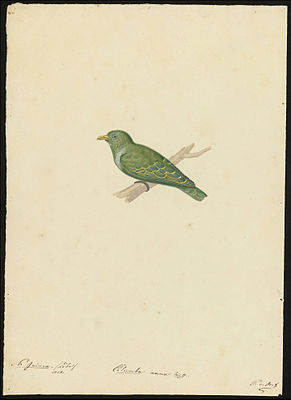Dwarf pigeon
| Dwarf pigeon | ||||||||||
|---|---|---|---|---|---|---|---|---|---|---|

Dwarf pigeon, illustration from 1828 |
||||||||||
| Systematics | ||||||||||
|
||||||||||
| Scientific name | ||||||||||
| Ptilinopus naina | ||||||||||
| ( Temminck , 1835) |
The dwarf fruit dove ( Ptilinopus naina ) is a species of pigeon birds. It occurs in two subspecies in Southeast Asia. Very little is known about their way of life. The species is classified as not endangered by the IUCN .
Appearance
The dwarf fruit pigeon reaches a size of 13 to 15 centimeters. This is roughly the size of a sparrow. The dwarf fruit pigeon is one of the smallest pigeons at all. It is the smallest species among the fruit pigeons. Compared to the similarly large diamond pigeon, the dwarf fruit pigeon is a little more compact. Their tail is a little shorter. There is a gender dimorphism .
In the male, the plumage is deep green and has a bronze shimmer. The elytra are slightly darker than the body plumage. The feathers of the wing covers have yellow edges. The belly has a purple spot. There is a gray spot on each of the abdominal sides. The under tail-coverts are yellow. The beak is greenish. The iris is light gray inside and has a dark gray outer ring. The dark circles are blue-gray. The feet are reddish. Females are similar to males. However, they lack both the belly spot and the two spots on the sides of the chest.
Spread and behavior
The nominate form Ptilinopus naina naina lives in the south of New Guinea. The subspecies Ptilinopus naina minimus occurs on the Radja Ampat islands of Waigeoa and Salawati. The dwarf fruit pigeon mainly lives in the closed treetop zone of rainforests. It populates low and hill country up to a height of 1,100 meters. It does not form larger swarms, but lives either individually or in pairs. Loose gatherings of dwarf pigeons can occur when individual trees bear abundant fruit. Basically, it is a very difficult to observe species, which is very difficult to spot because of its inconspicuous plumage in the treetops. According to research, the fruits of a single fig species make up 68 percent of their diet.
supporting documents
Individual evidence
literature
- David Gibbs, Eustace Barnes and John Cox: Pigeons and Doves - A Guide to the Pigeons and Doves of the World . Pica Press, Sussex 2001, ISBN 90-74345-26-3 .
- Gerhard Rösler: The wild pigeons of the earth - free living, keeping and breeding . M. & H. Schaper Verlag, Alfeld-Hannover 1996, ISBN 3-7944-0184-0 .
Web links
- Ptilinopus nainus in the endangered Red List species the IUCN 2012. Posted by: BirdLife International, 2012. Accessed September 2, 2013.